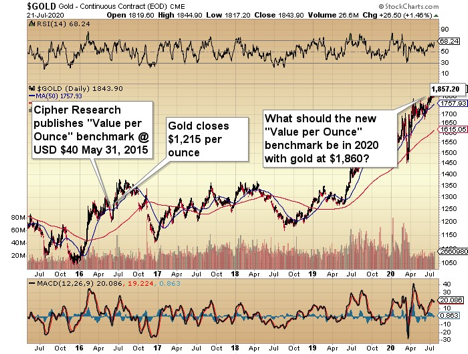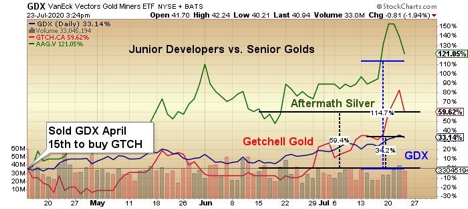Reading the hundreds upon hundreds of newsletter writers, bloggers, armchair analysts and professional money managers this past week skipping merrily down the road of self-aggrandizement, large meaty hands issuing congratulatory thumps squarely on their own puffed-out chests, I began to get the sense that a certain definable "froth" has descended upon us.
"Froth" is defined as "something that rises or overflows in a soft, light mass," as in a glass of beer or other carbonated soft drink, but for today's discussion, from a political perspective, "froth" is defined as "worthless or insubstantial talk, ideas, or activities." And nowhere was there less worth and insubstantial talk than in the Twitterverse, where the number of late claimants to the throne of the Golden Monarch has gone from three in 2019 to 3,000 in 2020 (and that's only in the English-speaking world).
I find it astonishing how people whom I have never heard of are popping up all over the place, offering to teach me how to trade gold and silver for $2,500/year, but are quick assure me that theirs is not "investment advice." Even the permabulls in gold and silver have taken to reminding us, through hourly podcasts and posts, that they "called the lows" last March, or last year, or last Shrove Tuesday, and that they are now up 1, 2, 3,000%, using a "proprietary system" available only to patrons or donors, refusing at all costs to ever refer to them as clients or customers or, God forbid, "subscribers."
If I get one more retweet of a bullish "call" made in 2016 qualifying the author for greatness and entry into the Precious Metals Hall of Fame, I swear I'm going to take my potato gun and aim it at the laptop.
Mark Hulbert pointed out a few days ago that gold market timers are more bullish today than they were at the top, in 2011, while the daily sentiment index for gold is at an alarming 91 and silver at an outright frightening 93.
Now, it does not mean that I am turning bearish on the precious metals (PMs), nor am I dumping my junior developers, but it does force me to keep a reasonably fat cash position in both the portfolio and trading accounts. Failing that, a modest hedge in the silver options could offset weakness in the event a correction materializes.
Whether it is rampaging bullish sentiment or blogospheric hubris, the time has arrived for increased caution, and even some profit-taking in the seniors and intermediate gold producers.
However, as the title of today's missive would suggest, it is not the time to exit the marginal producers and most certainly not the time to exit my beloved developers.
I am going to repost a section of my last GGMA Email Alert (2020-116), in which I made reference to the May 31, 2015, report by Vancouver-based Cipher Research, in which they laid out their base-case analysis for determining what an ounce of gold is worth to a junior developer sitting on a resource. The link to the report can be found here: The Real Value of Gold in the Ground.pdf.
From that report, the conclusions drawn are as follows:
➢ 80% of all transaction occur at $90/oz or less; over half (56%) occurred below $45/oz
➢ With the exception of a few outliers, there is little or no correlation to the price of gold
➢ The average price paid for gold in the ground was $63/oz
➢ The median price was $39/oz
➢ Slightly higher premiums were paid for projects in development or production, versus resource definition stage
➢ Average price is 33% higher ($52 versus $69/oz)
➢ Median is 18% higher ($34 versus $40/oz)
➢ There is surprisingly little difference in prices based on geographical location. (Although not measured, we believe that this is a result of the cumulative effect of all risk premium attached—for instance, high political risk in some jurisdictions may be offset by low permitting risk)
➢ The size of the resource was not positively correlated to the price paid (in other words, miners pay for the quality of the project, not the quantity of ounces)
At the time of issuance of this report, gold was sitting at around $1,215 per ounce and had endured four long years of a bear market, with the mining stocks (including marginal producers and pre-production developers) all suffering from lack of attention and consensus ridicule. As a result, the data upon which Cipher drew their conclusions was skewed to the downside by 2015 gold market conditions and the miserable state of the industry. Low prices and high costs ($60/barrel for oil) delayed or invalidated projects that, four years earlier, were given positive feasibility, a condition that did not begin to rectify until the following December, when gold finally bottomed at $1,045.
Fast forward to July 2020: Gold is approaching all-time high ground and oil is 33% lower than in 2015; conditions have dramatically improved. In fact, where on our planet are fundamentals so unarguably positive for any sector of the global economy?

Now I offer a look at the gold price chart showing the point in 2015 where the benchmark was set at around US$40/ounce of gold. Since then, gold has advanced over 50.3%, or US$612 per ounce and has now forced the market to re-evaluate "in ground value per ounce" for junior developers.
The 2020 argument in favor of gold is well documented and strongly underpinned, thanks to the insanity of our serial debt-printing central bankers. Maddeningly, it also the mindless insistence of the banco-politico class to engage in policies intended to not only secure the status quo, but also to persuade large blocks of the youth movement across the political divide and into the MMT camp, where work is unnecessary and saving money is irrelevant because the government is ready, willing and able to hand it out without conditions. In fact, owning a "savings account" is something granddad did, and mom and dad did, and the only time a millennial used it was to access the trust fund they were provided.
For a myriad of reasons, while the senior and junior gold miners have had blistering years in performance, the acceleration in earnings and free cash flow from elevated gold and silver prices and lower energy costs is going to launch them into still a new paradigm. The more youthful of the institutional community, who have never owned anything vaguely resembling a gold or silver equity, are today being dragged, kicking and screaming, into positions that they were told were nothing better than a "pet rock."
So, while all the visible names like Barrick Gold Corp. (ABX:TSX; GOLD:NYSE) and Newmont Corp. (NEM:NYSE) and Agnico Eagle Mines Ltd. (AEM:TSX; AEM:NYSE) are being slowly acquired by an entirely new generation of investors, it is going to take a great deal of "catch-up" to bring these kiddies up to speed in terms of evaluating the high-cost marginal producer and the highly-leveraged junior developer—and therein lies the opportunity and the beauty of owning this lagging sector. It is the leverage to the gold price that creates ten-bagger and twenty-bagger potential.
I made the decision back in mid-April to switch my senior and junior gold exchange-traded funds (ETFs) to a basket of junior developer/explorers to capture the majesty of the inevitable rotation of large capital flows into the more speculative names. In prior cycles, timing such a move requires incredible patience and nerve, because if you are too early or too late, you wind up in trouble. Worse still, you can end up with "dead money" in the juniors while you watch the big boys ramp higher (bringing on varying degrees of suicidal tendency).
I would love to pronounce that my prescient abilities timed this year's rotation to perfection, but what actually made it effective was the arrival of the pandemic in March and then the panic-button reactions by the central banks and governments around the world. The chart below is a good illustration of the relative performance of GDX versus my two largest positions (Aftermath Silver Ltd. [AAG:TSX.V] and Getchell Gold Corp. [GTCH:CSE]) since mid-April.

Looking out to 2021, I contend that the $40/ounce valuation used as a benchmark in May 2015 is drastically too conservative in a world of $1,885 gold. If you find a junior developer with 1,000,000 ounces whose preliminary economic analysis threw out a 5% ROI [return on investment] at $1,215 gold, it experiences a geometric increase in the ROI figure when the new price is plugged into the model. On many occasions, 5% ROI comes 500% ROI, with net present values more than quadrupling all because of the leverage to rising prices.
Furthermore, when one factors in energy, you have a double whammy of impact on profitability, and while it is a boon for the majors, it is like a Red Bull amphetamine for the marginal producers and especially developers (like Getchell and Aftermath), where they have undervalued ounces worth many times more today than in 2015.
In the interest of full disclosure, I am shamelessly "talking my book" in using Getchell Gold's 1,069,000 ounces in my illustration of how revaluation of ounces in the ground can impact the share price performance. It also illustrates the kinds of deposits I want to own, because the marginal ones are still underowned while the high-grade ones are fully owned.
As an example, using Getchell Gold's 1,069,000 ounces as a minimum gold resource, the $40 per ounce figure implies a valuation of US$42.76 million, or US$0.459 (assuming full dilution of 93,010,619 issued) or CA$0.62 per share. With the last trade at US$0.31, there is still an implied discount of 32.5% to fair value, representing a compelling reason to continue to hold the stock and add to positions at current levels.
However, this methodology is using an outdated model, because the assumptions used in 2015 to arrive at that US$40/ounce number have changed dramatically, increasing the margin expansion outlook for the foreseeable future. I maintain the junior developers should today be using US$80 per ounce as a benchmark, and once gold achieves escape velocity beyond the 2011 highs at around US$1,900, a US$100/ounce-plus benchmark will be accepted for all developing resources.
I am not going to speculate, in this example, as to how many additional ounces will be established this year as drilling commences in two to three weeks on the highly prospective Tenneco, Pack Rat, and Colorado zones, or from the Revised Resource Estimate that will include these new proven gold-bearing structures. I am, however, going to speculate on the revaluation of Getchell's Fondaway Canyon Assets based upon July 2020 gold prices.
➢ Using US$80 per ounce, Getchell is fair value up to US$85.52 million, or US$0.919 or CA$1.23 per share.
➢ At US$100 per ounce, Getchell is fair value up to US$106,900,000. or US$1.149 or CA$1.546 per share.
There are dozens upon dozens of these types of companies that have defined resources, where irrespective of drilling, they will be revalued upward as gold rises. The key is in looking at the assumptions used in the calculation of ROI, with obviously the gold price and the cost of unleaded gas (or diesel) being the first stopping points.
I maintain that eventually, the junior explorers will also get discovered by this new generation of speculators, replacing the developers as the sector of choice as this golden bull matures and broadens out in terms of volumes and exposure.
For now, however, developers that were thrown under a bus back in 2015 because the resource was marginal at US$1,215 gold find themselves in greater and greater demand because of the lack of exploration risk and the certainty of tracking higher as those ounces are reranked by the analytical community.
Lastly, with the Van Eck Junior Gold ETF (GDXJ:US) now really only owning junior producers and very few (if any) non-producers, it forces the average investor to seek out the right opportunities rather than letting the ETF manager make the selections. Because the manager many times is prohibited from buying a company either too small or illiquid, the prices I pay are spectacular once those ounces are rerated, thus rendering these companies "eligible," but at levels many multiples higher than today's prices.
Conclusion: Buy the junior developers.
Originally published July 25, 2020.
Follow Michael Ballanger on Twitter @MiningJunkie.
Originally trained during the inflationary 1970s, Michael Ballanger is a graduate of Saint Louis University where he earned a Bachelor of Science in finance and a Bachelor of Art in marketing before completing post-graduate work at the Wharton School of Finance. With more than 30 years of experience as a junior mining and exploration specialist, as well as a solid background in corporate finance, Ballanger's adherence to the concept of "Hard Assets" allows him to focus the practice on selecting opportunities in the global resource sector with emphasis on the precious metals exploration and development sector. Ballanger takes great pleasure in visiting mineral properties around the globe in the never-ending hunt for early-stage opportunities.
[NLINSERT]Disclosure:
1) Michael J. Ballanger: I, or members of my immediate household or family, own securities of the following companies mentioned in this article: Getchell Gold, Aftermath Silver. My company has a financial relationship with the following companies referred to in this article: Getchell Gold, Aftermath Silver. I determined which companies would be included in this article based on my research and understanding of the sector. Additional disclosures are below.
2) The following companies mentioned in this article are billboard sponsors of Streetwise Reports: None. Click here for important disclosures about sponsor fees.
3) Statements and opinions expressed are the opinions of the author and not of Streetwise Reports or its officers. The author is wholly responsible for the validity of the statements. The author was not paid by Streetwise Reports for this article. Streetwise Reports was not paid by the author to publish or syndicate this article. Streetwise Reports requires contributing authors to disclose any shareholdings in, or economic relationships with, companies that they write about. Streetwise Reports relies upon the authors to accurately provide this information and Streetwise Reports has no means of verifying its accuracy.
4) This article does not constitute investment advice. Each reader is encouraged to consult with his or her individual financial professional and any action a reader takes as a result of information presented here is his or her own responsibility. By opening this page, each reader accepts and agrees to Streetwise Reports' terms of use and full legal disclaimer. This article is not a solicitation for investment. Streetwise Reports does not render general or specific investment advice and the information on Streetwise Reports should not be considered a recommendation to buy or sell any security. Streetwise Reports does not endorse or recommend the business, products, services or securities of any company mentioned on Streetwise Reports.
5) From time to time, Streetwise Reports LLC and its directors, officers, employees or members of their families, as well as persons interviewed for articles and interviews on the site, may have a long or short position in securities mentioned. Directors, officers, employees or members of their immediate families are prohibited from making purchases and/or sales of those securities in the open market or otherwise from the time of the interview or the decision to write an article until three business days after the publication of the interview or article. The foregoing prohibition does not apply to articles that in substance only restate previously published company releases. As of the date of this article, officers and/or employees of Streetwise Reports LLC (including members of their household) own securities of Getchell Gold, Newmont Corp. and Aftermath Silver, companies mentioned in this article.
Michael Ballanger Disclaimer:
This letter makes no guarantee or warranty on the accuracy or completeness of the data provided. Nothing contained herein is intended or shall be deemed to be investment advice, implied or otherwise. This letter represents my views and replicates trades that I am making but nothing more than that. Always consult your registered advisor to assist you with your investments. I accept no liability for any loss arising from the use of the data contained on this letter. Options and junior mining stocks contain a high level of risk that may result in the loss of part or all invested capital and therefore are suitable for experienced and professional investors and traders only. One should be familiar with the risks involved in junior mining and options trading and we recommend consulting a financial adviser if you feel you do not understand the risks involved.





























































